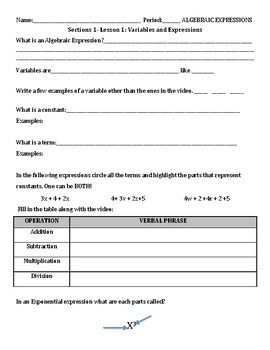Algebra 1: Algebraic & Verbal Expressions Blended Classroom Lesson
Miss G's Math
24 Followers
Miss G's Math
24 Followers

Includes Google Apps™
The Teacher-Author indicated this resource includes assets from Google Workspace (e.g. docs, slides, etc.).
Description
This is a full lesson with notes I made myself. I am in the process of building an entire Algebra 1 Blended Classroom Curriculum and I am posting some individual lessons to get feedback. This is what a lesson will be similar to. I have included with this...
- A checklist of the day's lesson and procedures. PDF so you may need to make your own to fit your classroom
- A link to Google Form for the notes that I use as a notes quiz to make sure the students are listening to the lesson and paying attention to the details of the notes
- A PDF and Word document of the notes. There is also a warm-up attached at the end I created that could be used before the lesson or as an exit ticket for after the lesson.
- A link to my Youtube video that the student watch
- A link to the activity I do at the end that I bought from Teacher's Pay Teachers so that you can do that activity as well or choose another and have the students stop the video earlier.
Please let me know how it works and how it goes!
Total Pages
Answer Key
Included
Teaching Duration
90 minutes
Report this resource to TPT
Reported resources will be reviewed by our team. Report this resource to let us know if this resource violates TPT’s content guidelines.
Standards
to see state-specific standards (only available in the US).
CCSSHSA-SSE.A.1
Interpret expressions that represent a quantity in terms of its context.
CCSSHSA-SSE.A.1a
Interpret parts of an expression, such as terms, factors, and coefficients.
CCSSMP4
Model with mathematics. Mathematically proficient students can apply the mathematics they know to solve problems arising in everyday life, society, and the workplace. In early grades, this might be as simple as writing an addition equation to describe a situation. In middle grades, a student might apply proportional reasoning to plan a school event or analyze a problem in the community. By high school, a student might use geometry to solve a design problem or use a function to describe how one quantity of interest depends on another. Mathematically proficient students who can apply what they know are comfortable making assumptions and approximations to simplify a complicated situation, realizing that these may need revision later. They are able to identify important quantities in a practical situation and map their relationships using such tools as diagrams, two-way tables, graphs, flowcharts and formulas. They can analyze those relationships mathematically to draw conclusions. They routinely interpret their mathematical results in the context of the situation and reflect on whether the results make sense, possibly improving the model if it has not served its purpose.




